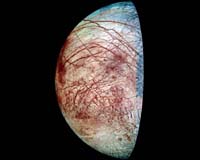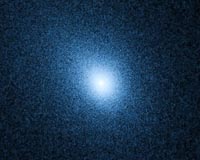|
 Titan's Hazes May Hold Ingredients Of Life
Titan's Hazes May Hold Ingredients Of LifeTucson AZ (SPX) Oct 11, 2010 Simulating possible chemical processes in the atmosphere of Titan, Saturn's largest moon, an international team including University of Arizona graduate student Sarah Horst and Professor Roger Yelle demonstrated the synthesis of complex organic compounds, such as amino acids and nucleotide bases, which are the basic building blocks of life on Earth. The molecules discovered include the five nucleotide bases used by life on Earth (cytosine, adenine, thymine, guanine and uracil) and the two smallest ... read more |
. |
|
|
Free Space, Earth, Energy And Military Newsletters - Delivered Daily |
| . | . |
| .. |
WISE Captures Key Images Of Comet Mission Destination Pasadena CA (JPL) Oct 06, 2010
Pasadena CA (JPL) Oct 06, 2010NASA's Wide-field Infrared Survey Explorer, or WISE, caught a glimpse of the comet that the agency's EPOXI mission will visit in November. The WISE observation will help the EPOXI team put together a large-scale picture of the comet, known as Hartley 2. "WISE's infrared vision provides data that complement what EPOXI will see with its visible-light and near-infrared instruments," said Jame ... more Orbital Environment For Dawn Spacecraft At Vesta  Pasadena CA (JPL) Oct 05, 2010
Pasadena CA (JPL) Oct 05, 2010A detailed study of the dynamics of the Dawn spacecraft as it orbits the large Arizona-sized, non-spherical asteroid Vesta next summer in 2011 reveals one of the most complex operational environments for a NASA mission to date. This work has implications for future mission planning to other large asteroids. A paper on the research titled "The Dynamical Environment of Dawn at Vesta" by Pasq ... more Pushing The Envelope Leaves A Blast Of Relativistic Particles  Huntsville AL (SPX) Oct 06, 2010
Huntsville AL (SPX) Oct 06, 2010G327.1-1.1 is the aftermath of a massive star that exploded as a supernova in the Milky Way galaxy. A highly magnetic, rapidly spinning neutron star called a pulsar was left behind after the explosion and is producing a wind of relativistic particles, seen in X-rays by Chandra and XMM-Newton (blue) as well as in the radio data (red and yellow). This structure is called a pulsar wind nebula ... more |
.. |
 Europa's Hidden Ice Chemistry  Hubble Probes Comet 103P Hartley 2 In Preparation For DIXI flyby  Instant online solar energy quotes Solar Energy Solutions from ABC Solar |
.. |
|
|
Free Space, Earth, Energy And Military Newsletters - Delivered Daily |
|
|
. |
 Powerful Supercomputer Peers Into The Origin Of Life
Powerful Supercomputer Peers Into The Origin Of LifeOak Ridge TN (SPX) Oct 06, 2010 Supercomputer simulations at the Department of Energy's Oak Ridge National Laboratory are helping scientists unravel how nucleic acids could have contributed to the origins of life. A research team led by Jeremy Smith, who directs ORNL's Center for Molecular Biophysics and holds a Governor's Chair at University of Tennessee, used molecular dynamics simulation to probe an organic chemical reaction that may have been important in the evolution of ribonucleic acids, or RNA, into early life forms. ... read more |
| The contents herein, unless otherwise known to be public domain, are Copyright 1995-2010 - SpaceDaily. AFP and UPI Wire Stories are copyright Agence France-Presse and United Press International. ESA Portal Reports are copyright European Space Agency. All NASA sourced material is public domain. Additional copyrights may apply in whole or part to other bona fide parties. Advertising does not imply endorsement, agreement or approval of any opinions, statements or information provided by SpaceDaily on any web page published or hosted by SpaceDaily. Privacy statement |
| Previous Issues | Oct 08 | Oct 07 | Oct 06 | Oct 05 | Oct 04 |